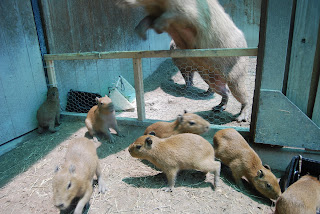This is a picture of Lucy.
Lucy was a Capybara. She, along with her mate, Desi, lived at the Heard Museum in her enclosure in the 'Animals of the World' exhibit. Last Saturday night, she died unexpectedly. Up until then, Lucy seemed healthy. She had the best appetite of all of the animals there. Yesterday morning, the vet performed a necropsy to see what happened to her. (A necropsy is like an autopsy on humans only for animals it's known as a 'necropsy.') The necropsy revealed that she had a tumor in her intestines the size of a bowling ball. The tumor was what ended her life. She gave no outward appearance of being sick or having this tumor. She was a prey animal and prey animals tend not to show that they are sick until it is near the very end because it makes them more vulnerable to predators.
Lucy and some of her babies
Lucy (front) and Desi (back) and some of their babies (born last year).
Lucy jumping over the little fence so she can check on her babies.
Capybara mate for life. Her mate was Desi. He is very upset over her loss and doesn't know what to think. All he knows is that she is no longer there and he misses her. They have been together since they were youngsters and before they came to live at the Heard. Desi felt it was his duty to watch over Lucy and protect her, but nobody could protect her from the cancer.
The Capybara is the world's largest rodent and can weigh up to 150 pounds full grown. They are related to mice, rats and Guinea Pigs. Like all rodents, they need to gnaw on things constantly to keep their teeth from growing into their mouths. The Capybara comes from South America and being the world's largest rodent, is prey to the world's largest snake, the anaconda. They are herbivores and chew their cud similar to a cow. When they aren't happy about something, they bark, not quite like a dog, but it's a definite bark. They also make a variety of chirps and squeaks to communicate with one another. Capybara are designed for the water. They love the water and are excellent swimmers. They have webbed feet and can stay under water for up to 5 minutes. They can even sleep in water with their noses sticking out of the water. Their noses, eyes and ears are set high on their heads to allow them to move about in the water with most of their body hidden under the water.
Some people keep them as pets. They can't be litter box trained. I've seen internet photos of Capybara swimming in someone's pool. Capys prefer to poop in the water. I'm sure their pool man had a nasty surprise waiting for him when he came to clean the pool. I don't think the chlorine would be real good for the Capys either. Capys are wild animals and haven't been domesticated like cats and dogs. They need a decent sized body of water which needs to be cleaned on a regular basis.
Lucy and Desi had two litters of babies. The babies were incredibly cute. Here are some more pictures of them:
Lucy was a good mom and fed her babies constantly. It was fun to feed Lucy and Desi, they were always so enthusiastic about getting their food, especially Lucy. When I put the food bowls down, Lucy would always make a beeline for the bowls. She wasn't picky either, she loved whatever we fed her. We separated the bowls so Desi would get some too. Right now, the field near the cage is full of fresh green spring grass, we always bring them some of the grass in the spring. I wish Lucy were there to enjoy it, she loved fresh grass.
Now, when I think of the names Lucy and Desi, I think of two big, gentle Capybara, not some 1950's TV comedy. I will give Desi some fresh, green grass from the field tomorrow. We loved Lucy and we miss her. So does Desi.









No comments:
Post a Comment